Dog Breed Traits: Shedding and Allergies
By Michele Welton, Dog Trainer, Breed Selection Consultant, Author of 15 Dog Books
Fencing needed for confinement
Risk of Aggression Toward People
Risk of Aggression Toward Other Dogs
What are the biggest mistakes owners make about shedding?
They bring home a German Shepherd, Dalmatian, Beagle, Cocker Spaniel, Corgi, Newfoundland, Siberian Husky, etc..... and within a year or two, the dog is given up because of "too much shedding."
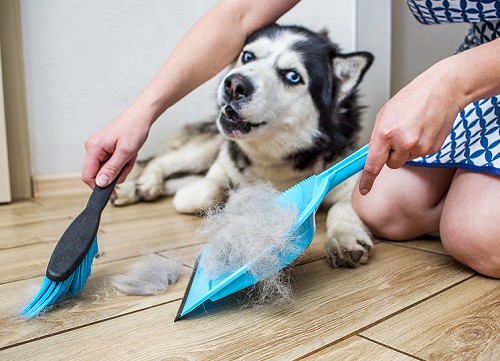
Siberian Huskies shed. A lot. As do all other breeds with a thick double coat.
How much a dog sheds is completely forseeable. You just need to do a little research before bringing him home. Unfortunately, breeders are not the best source for research on shedding, as breeders typically downplay it. My reviews, though, will tell you exactly what to expect.
What is shedding, anyway?
Shedding is when old, dead hair falls off your dog, to be replaced by new, living hair. Only a handful are non-shedders. A few more breeds are light shedders. Most breeds are average to heavy shedders.
Prospective owners are usually eager to learn about the non-shedders, so let's start there!
NON-SHEDDERS
Virtually all dogs shed. There are only two types of dogs that don't shed:
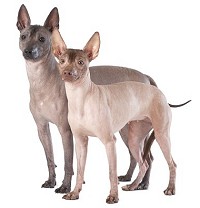
Xoloitzcuintle, affectionately nicknamed Xolo (pronounced SHO-lo)
Dogs with no hair don't shed. Obvious, right?
Hairless breeds include the Chinese Crested, the Xoloitzcuintli (aka Mexican Hairless), and the Peruvian Inca Orchid.
The appearance of these dogs isn't everyone's cup of tea. But if you're interested, be aware that these breeds have certain health issues and eccentric behaviors that can make them complicated to live with. They really belong with experienced owners.
Dogs with continuously growing hair don't (hardly) shed.
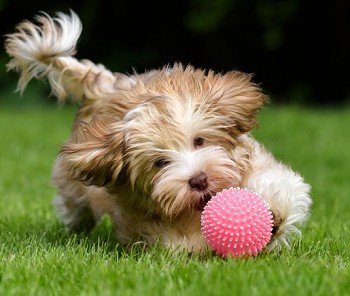
Havanese (along with several related cousins) shed minimally and have playful personalities, for homes without young children.
In dog breeds that shed, their hair has a life cycle where it grows, then dies, then falls out as it's being replaced by a new hair pushing up from beneath the skin.
That doesn't happen in dogs with continuously growing hair. Oh, they will definitely lose hair from time to time – hairs that accidentally break off, or get pulled out when you brush or bathe them (just as when you brush or wash your own hair).
But in general, their hair stays put, so if you let it keep growing, soon the long strands will twist and tangle into horrible mats.
To prevent that, you must use scissors or clippers every few months to cut the growing hair. Sadly, significant grooming is the price you pay for NON-SHEDDING.
"Which dog breeds have continuously growing hair that doesn't shed?"
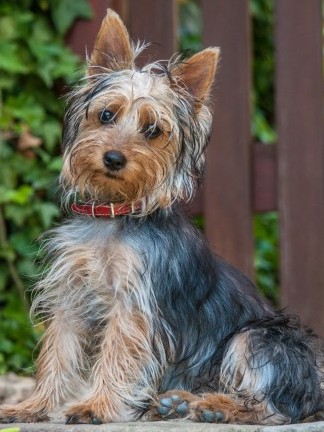
Silky Terriers don't shed, so need regular brushing, combing, and trimming to keep their coat short(ish) and neat/clean.
- Poodles (Toy, Miniature, Standard)
- Bichon Frise
- Maltese
- Havanese
- Coton de Tulear
- Bolognese
- Lowchen
- Silky Terrier
- Yorkshire Terrier
...plus crosses of these breeds with each other. (If a non-shedder is crossed with any other kind of shedder, their offspring will NOT be non-shedders.)
 Along with no shedding, these breeds have sweet, fun-loving personalities – bright, cheerful, and playful. However, I only recommend them for homes with older, gentle, respectful children.
Along with no shedding, these breeds have sweet, fun-loving personalities – bright, cheerful, and playful. However, I only recommend them for homes with older, gentle, respectful children.
 Along with needing a lot of grooming, all of these breeds (except Poodles) tend to be hard to housebreak. The worst offenders are Yorkies, Maltese, and Bichons... but the others (except Poodles) aren't far behind!
Along with needing a lot of grooming, all of these breeds (except Poodles) tend to be hard to housebreak. The worst offenders are Yorkies, Maltese, and Bichons... but the others (except Poodles) aren't far behind!
LIGHT SHEDDERS
LIGHT shedding means that now and again you'll find some hair on your clothing or furniture – more hair than you would find from NON-SHEDDERS.
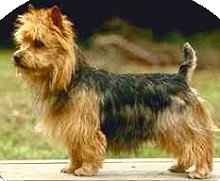
Most terrier breeds are remarkably similar: quick to bark, quick to chase, lively, bossy, feisty, scrappy, clever, independent, stubborn, persistent, impulsive, intense. This is an Australian Terrier.
About two dozen breeds are in this group – mostly terrier breeds that need a moderate to significant amount of brushing and clipping. Examples include the Australian Terrier, Cairn Terrier, Scottish Terrier, Wirehaired Fox Terrier, and Soft-Coated Wheaten.
Terriers are a bit... shall we say, "independent" and "obstinate." Not great for first-time dog owners, definitely not for young children. But pretty cool dogs for the right owner.
Aside from terriers, other LIGHT shedders include:
- Basenji
- Giant Schnauzer
- Italian Greyhound
- Lagotto Romagnolo
- Standard Schnauzer
- Portuguese Water Dog
- Powderpuff Chinese Crested
The light shedders in the list above all belong with experienced owners. No little kids. Fences should be high and non-climbable, as these breeds are active and athletic jumpers.
Finally, there are a few LIGHT shedders that can make good pets for the average family. They're all a bit stubborn, but fit well into most families as long as you keep up with the significant coat care:
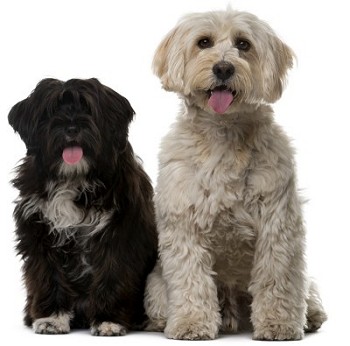
The Tibetan Terrier is lively and playful, but not hyperactive. Although a bit stubborn, also calm and low-key. He is a moderate dog in all respects and can adapt to most homes with sufficient exercise (and of course proper coat care).
- Shih Tzu: nice breed, easy to live with except that housebreaking can go slowly
- Tibetan Terrier: this breed is misnamed – it is not a terrier and doesn't act like one (see photo and caption)
- Miniature Schnauzer: some individuals are as tough as their terrier cousins, while others are milder-mannered
- Dachshund (Wirehaired): note that Smooth Dachshunds and Longhaired Dachshunds are average shedders, not light
AVERAGE SHEDDERS
The majority of dog breeds are AVERAGE shedders. They shed twice a year – a 3-week shedding period in spring, then another in autumn.
However, that's not the end of their shedding. Living inside our temperature-controlled homes, average shedders also shed very small amounts of hair throughout the year. (This ongoing shedding is more noticeable in larger dogs, less noticeable in smaller dogs.)
Here are some AVERAGE shedders that often make good pets for a typical family with no small children, as long as you can meet all their needs:
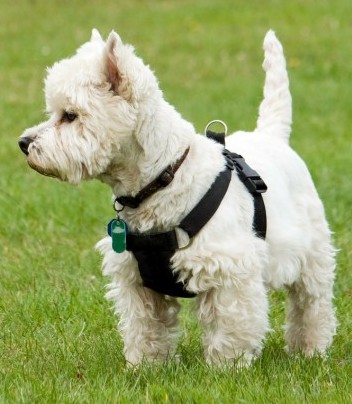
The West Highland White Terrier (Westie) is an AVERAGE shedder with a confident, opinionated temperament. His coat does need significant trimming/clipping.
- Boston Terrier
- Boxer
- Chihuahua
- Dachshund (Longhaired or Smooth)
- Greyhound
- Papillon
- Rat Terrier
- Toy Fox Terrier
- Vizsla
- Whippet
- Spinone Italiano (needs significant trimming/clipping)
- West Highland White Terrier (needs significant trimming/clipping)
HEAVY SHEDDERS
As you might expect, heavy shedding is not a highly requested trait! I've never met a prospective owner who said he was eager to get a new dog that sheds heavily. Unless you're planning to spin that fur into yarn, why would anyone?
But you might choose to accept heavy shedding if you and the dog were otherwise a good match. Or you might not – heavy shedding might be a deal-breaker for you.
Heavy shedders fall into two categories:
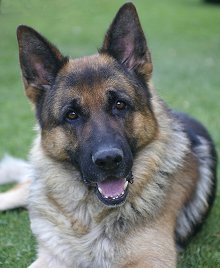
The good news is that German Shepherds have only one shedding period a year. The bad news is it lasts for 365 days!
Constant heavy shedders
Constant shedders shed a minimal to moderate amount of hair every day, plus a moderate amount of hair during the 3-week shedding seasons (spring and fall).
So year-round, you'll find hair stuck tenaciously to your pants and curling under your fridge. Frequent vacuuming will become a way of life.
Examples of constant heavy shedders include German Shepherds, Dalmatians, Beagles, Pugs, Smooth Jack Russell Terriers, and others.
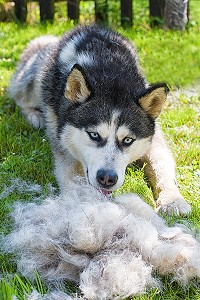
If you don't mind raking this out of your dog's coat every day, for several weeks, consider a Siberian Husky. Otherwise...
Seasonal heavy shedders
Seasonal shedders shed a minimal to moderate amount of hair off and on throughout the year – plus an absolute blizzard of hair during the 3-week shedding seasons (spring and fall).
Examples of seasonal heavy shedders: Australian Shepherds, Bernese Mountain Dogs, Chows, Cocker Spaniels, Collies, Golden Retrievers, Labrador Retrievers, Newfoundlands, Norwegian Elkhounds, Pomeranians, Saint Bernards, Shelties, Siberian Huskies, Welsh Corgis, and others
If you're allergic to dogs....
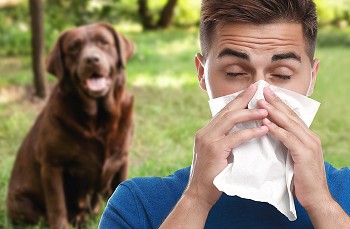
About 20% of Americans are allergic to dogs. And that percentage increases if you also have an allergy to something else. One allergy often leads to more allergies.
You should find out from your doctor WHAT KIND of dog allergy you actually have.
The vast majority of people who are "allergic to dogs" are not reacting to canine hair but to:
- canine dander (flaky dead skin cells) and sebum (oil produced by sebaceous glands under the skin)
- or canine saliva (from the dog's mouth)
To be more accurate, the proteins found in dander, sebum, and saliva are what people over-react to when their immune system is defective. A normal immune system doesn't react to such harmless things.
"My doctor says I'm allergic to canine dander/sebum."
Okay, that's better than being allergic to saliva. The same breeds that don't shed (because their hair grows continuously until you cut it) also produce less dander/sebum. These breeds are the best choices for people who are allergic to dander/sebum.
There is some evidence that people may be allergic to one specific breed but not another specific breed, even when the breeds seem similar. So you might be fine with a Miniature Poodle but not with a Bichon Frise, or vice versa. Sadly, allergies can be tough to predict.
Also keep in mind that when you're allergic to one thing, you're more likely to become allergic to other things. So you might start out by being allergic only to dander, but in a year or two or three, you might also become allergic to saliva, which is much more difficult to mitigate.
MY ADVICE: Stick with NON-SHEDDING breeds – and pray.
"My doctor says I'm allergic to canine saliva."
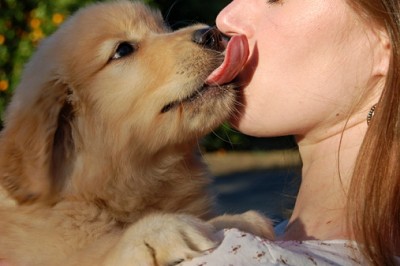
Lick! Puppy loves you! Though it might not feel much like love if you start sneezing. Many allergic peoople think they're reacting to dog hair or dander, when they're actually reacting to certain proteins in a dog's saliva.
Oh dear. Saliva is the most common canine allergen. Not hair, dander, or sebum. Saliva.
And it's the worst one to try to get around.
Here's the problem: dogs lick. They lick your hands, they lick their toys (which you then pick up), they lick their own fur (which you then pet).
Some people have tried to minimize a saliva allergy by:
- avoiding breeds who drool or slobber
- preventing the dog from licking them
- not handling the dog's toys
- petting the dog only on un-lickable parts of his body – on top of his head, or on his chest and back
- having other family members brush the dog's teeth and clip the dog's nails (dogs often lick their paws)
MY ADVICE: Honestly I don't recommend a dog in this situation. But if you think you can do everything on the above list, you should at least stick with NON-SHEDDING breeds in case you also develop a dander/sebum allergy.
"My doctor says I'm allergic to pollen, dust mites, and cats... but not dogs. Does that mean I can choose any breed?"
That would be risky. If you have some other allergy, your immune system is inappropriately over-reacting to harmless things such as pollen or dust mites.
So you might start out by being allergic to, say, tree pollen. A year later, you might add dust mites as an allergen. Two years after that, you add canine dander... or even worse, canine saliva.
MY ADVICE: Stick with NON-SHEDDING breeds.
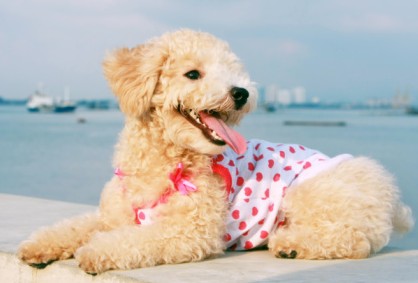
Poodles are the safest of all breeds for allergy sufferers.
"Can I test whether I'm allergic to a certain breed by visiting a breeder's kennel?"
This can help CONFIRM an allergy. If you react from one simple visit, you have your answer.
But the problem is that you might not react right away. You could spend hours at a breeder's house, playing with his dogs, and be perfectly fine.
But once a dog is actually living with you 24 hours a day, 7 days a week, and especially once a puppy sheds his baby coat and dons his adult coat, you may find that NOW your nose starts running, your eyes start watering, and so on.
It is a very sad thing to bring home a dog and discover, after a few months or years, that you're too allergic to keep him. Sad not only for you, but for the poor dog who must adjust to yet another new home.
If you do decide to try the breeder test, visit multiple breeders, not just one. And make sure you're monitoring your reactions only to the breeder's ADULT dogs.
Don't try to judge allergic reactions to PUPPIES. A puppy's soft supple skin doesn't produce much dander or oil this process only occurs in adult dogs. So hang out with the adult dogs.
My best-selling books – now available FREE on my website
 Respect Training For Puppies: 30 seconds to a calm, polite, well-behaved puppy is for puppies 2 to 18 months old. Your puppy will learn the 21 skills that all family dogs need to know. Click here to read for free.
Respect Training For Puppies: 30 seconds to a calm, polite, well-behaved puppy is for puppies 2 to 18 months old. Your puppy will learn the 21 skills that all family dogs need to know. Click here to read for free. Teach Your Dog 100 English Words is a unique Vocabulary and Respect Training Program that will teach your adult dog to listen to you and do what you say. Click here to read for free.
Teach Your Dog 100 English Words is a unique Vocabulary and Respect Training Program that will teach your adult dog to listen to you and do what you say. Click here to read for free. 11 Things You Must Do Right To Keep Your Dog Healthy and Happy helps your dog live a longer, healthier life. Get my honest advice about all 11 Things before you bring home your new puppy, because some mistakes with early health care cannot be undone. Click here to read for free.
11 Things You Must Do Right To Keep Your Dog Healthy and Happy helps your dog live a longer, healthier life. Get my honest advice about all 11 Things before you bring home your new puppy, because some mistakes with early health care cannot be undone. Click here to read for free.
